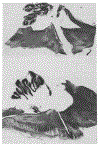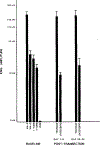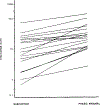Behavioral states in the chronic medullary and midpontine cat
- PMID: 2419085
- PMCID: PMC9045735
- DOI: 10.1016/0013-4694(86)90095-7
Behavioral states in the chronic medullary and midpontine cat
Abstract
Behavioral state organization was studied in the caudal portion of chronically maintained cats with transections at the ponto-medullary junction or midpontine level. The cats spent most of their time in a 'quiescent state.' This state was periodically interrupted by 'phasic activations.' During quiescence, ECG and reticular unit activity rates were low and regular. EMG levels resembled those seen during non-REM sleep in intact cats. During phasic activations, unit activity in the nucleus gigantocellularis and neck EMG activity increased to levels seen in the intact cat during active waking. Gross postural changes, vestibular slow phase head nystagmus and head shake reflexes could be observed at these times. No periods of neck muscle atonia were observed in either state. No periods of brain-stem controlled rapid eye movements (REMs) occurred. Unit activity patterns similar to those seen in the intact cat during REM sleep were never observed. Physostigmine administration did not produce REM sleep signs, but rather, triggered an aroused state. Phasic activations occurred in a regular ultradian rhythm, with a period similar to that seen in the REM sleep cycle. We conclude that the chronic medullary cat retains primitive aroused and quiescent states, but does not have any of the local signs of REM sleep. However, the medulla does have the capability of generating ultradian rhythmicities which may contribute to the control of the basic rest activity cycle and the REM, non-REM sleep cycle.
Figures









Similar articles
-
REM sleep signs rostral to chronic transections at the pontomedullary junction.Neurosci Lett. 1984 Apr 6;45(3):241-6. doi: 10.1016/0304-3940(84)90233-7. Neurosci Lett. 1984. PMID: 6728317 Free PMC article.
-
Behavioral response and transmitter release during atonia elicited by medial medullary stimulation.J Neurophysiol. 2010 Oct;104(4):2024-33. doi: 10.1152/jn.00528.2010. Epub 2010 Jul 28. J Neurophysiol. 2010. PMID: 20668280 Free PMC article.
-
Cholinergic mechanisms related to REM sleep. III. Tonic and phasic inhibition of monosynaptic reflexes induced by an anticholinesterase in the decerebrate cat.Arch Ital Biol. 1973 Feb;111(1):1-23. Arch Ital Biol. 1973. PMID: 18843824
-
Carbachol models of REM sleep: recent developments and new directions.Arch Ital Biol. 2001 Feb;139(1-2):147-68. Arch Ital Biol. 2001. PMID: 11256182 Review.
-
Paradoxical sleep and its chemical/structural substrates in the brain.Neuroscience. 1991;40(3):637-56. doi: 10.1016/0306-4522(91)90002-6. Neuroscience. 1991. PMID: 2062436 Review.
Cited by
-
Differentiating Oneiric Stupor in Agrypnia Excitata From Dreaming Disorders.Front Neurol. 2020 Nov 12;11:565694. doi: 10.3389/fneur.2020.565694. eCollection 2020. Front Neurol. 2020. PMID: 33281702 Free PMC article. Review.
-
Mechanisms of sleep control.J Clin Neurophysiol. 1990 Jan;7(1):49-65. doi: 10.1097/00004691-199001000-00005. J Clin Neurophysiol. 1990. PMID: 2406284 Free PMC article. Review.
-
REM sleep function: Mythology vs. reality.Rev Neurol (Paris). 2023 Oct;179(7):643-648. doi: 10.1016/j.neurol.2023.08.002. Epub 2023 Aug 23. Rev Neurol (Paris). 2023. PMID: 37625974 Free PMC article. Review.
-
Relevance of deprivation studies in understanding rapid eye movement sleep.Nat Sci Sleep. 2018 May 29;10:143-158. doi: 10.2147/NSS.S140621. eCollection 2018. Nat Sci Sleep. 2018. PMID: 29881316 Free PMC article. Review.
-
REM sleep: a biological and psychological paradox.Sleep Med Rev. 2011 Jun;15(3):139-42. doi: 10.1016/j.smrv.2011.01.001. Epub 2011 Apr 8. Sleep Med Rev. 2011. PMID: 21482156 Free PMC article. Review. No abstract available.
References
-
- Berman AL, The Brain Stem of the Cat. University of Wisconsin Press, Madison, WI, 1968.
-
- Bonvallet M and Bloch V Bulbar control of cortical arousal. Science, 1976, 133: 1133–1134. - PubMed
-
- De Andres I and Reinoso-Suarez F Participation of the cerebellum in the regulation of the sleep-wakefulness cycle through the superior cerebellum peduncle. Arch. ital. Biol, 1979, 117: 140–163. - PubMed
-
- Delorme F, Vimont P, et Jouvet D. Etude statistique du cycles veille-sommeils chez le chat. C.R. Soc. Biol. (Paris), 1964, 158: 2128–2130. - PubMed
-
- Dixon WJ, Brown MB, Engelman L, Frane JW, Hill MA, Jennrich RI and Toporek JD BMDP Statistical Software. University of California Press, Berkeley, CA, 1983.
Publication types
MeSH terms
Substances
Grants and funding
LinkOut - more resources
Full Text Sources
Miscellaneous
